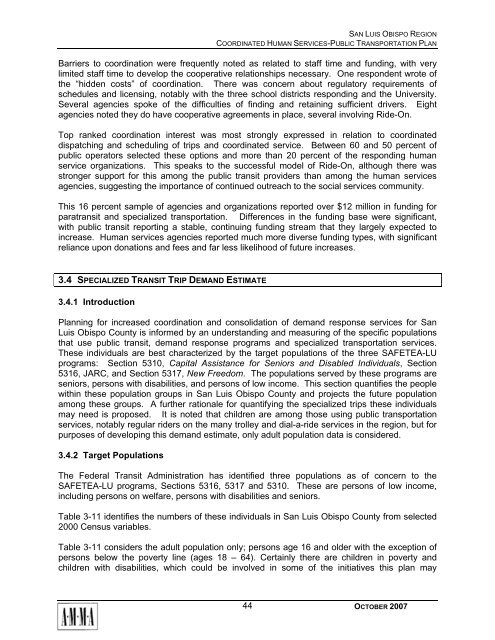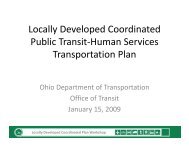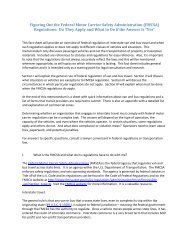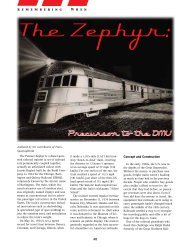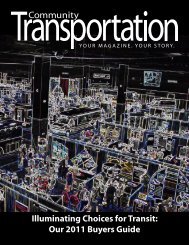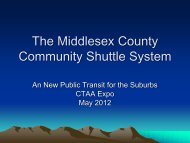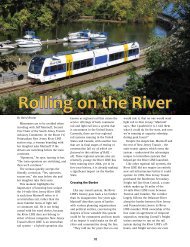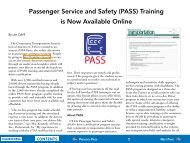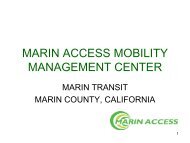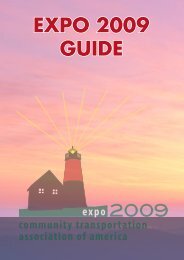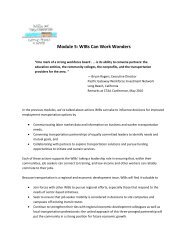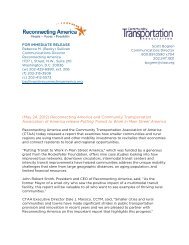San Luis Obispo - Caltrans - State of California
San Luis Obispo - Caltrans - State of California
San Luis Obispo - Caltrans - State of California
Create successful ePaper yourself
Turn your PDF publications into a flip-book with our unique Google optimized e-Paper software.
SAN LUIS OBISPO REGION<br />
COORDINATED HUMAN SERVICES-PUBLIC TRANSPORTATION PLAN<br />
Barriers to coordination were frequently noted as related to staff time and funding, with very<br />
limited staff time to develop the cooperative relationships necessary. One respondent wrote <strong>of</strong><br />
the “hidden costs” <strong>of</strong> coordination. There was concern about regulatory requirements <strong>of</strong><br />
schedules and licensing, notably with the three school districts responding and the University.<br />
Several agencies spoke <strong>of</strong> the difficulties <strong>of</strong> finding and retaining sufficient drivers. Eight<br />
agencies noted they do have cooperative agreements in place, several involving Ride-On.<br />
Top ranked coordination interest was most strongly expressed in relation to coordinated<br />
dispatching and scheduling <strong>of</strong> trips and coordinated service. Between 60 and 50 percent <strong>of</strong><br />
public operators selected these options and more than 20 percent <strong>of</strong> the responding human<br />
service organizations. This speaks to the successful model <strong>of</strong> Ride-On, although there was<br />
stronger support for this among the public transit providers than among the human services<br />
agencies, suggesting the importance <strong>of</strong> continued outreach to the social services community.<br />
This 16 percent sample <strong>of</strong> agencies and organizations reported over $12 million in funding for<br />
paratransit and specialized transportation. Differences in the funding base were significant,<br />
with public transit reporting a stable, continuing funding stream that they largely expected to<br />
increase. Human services agencies reported much more diverse funding types, with significant<br />
reliance upon donations and fees and far less likelihood <strong>of</strong> future increases.<br />
3.4 SPECIALIZED TRANSIT TRIP DEMAND ESTIMATE<br />
3.4.1 Introduction<br />
Planning for increased coordination and consolidation <strong>of</strong> demand response services for <strong>San</strong><br />
<strong>Luis</strong> <strong>Obispo</strong> County is informed by an understanding and measuring <strong>of</strong> the specific populations<br />
that use public transit, demand response programs and specialized transportation services.<br />
These individuals are best characterized by the target populations <strong>of</strong> the three SAFETEA-LU<br />
programs: Section 5310, Capital Assistance for Seniors and Disabled Individuals, Section<br />
5316, JARC, and Section 5317, New Freedom. The populations served by these programs are<br />
seniors, persons with disabilities, and persons <strong>of</strong> low income. This section quantifies the people<br />
within these population groups in <strong>San</strong> <strong>Luis</strong> <strong>Obispo</strong> County and projects the future population<br />
among these groups. A further rationale for quantifying the specialized trips these individuals<br />
may need is proposed. It is noted that children are among those using public transportation<br />
services, notably regular riders on the many trolley and dial-a-ride services in the region, but for<br />
purposes <strong>of</strong> developing this demand estimate, only adult population data is considered.<br />
3.4.2 Target Populations<br />
The Federal Transit Administration has identified three populations as <strong>of</strong> concern to the<br />
SAFETEA-LU programs, Sections 5316, 5317 and 5310. These are persons <strong>of</strong> low income,<br />
including persons on welfare, persons with disabilities and seniors.<br />
Table 3-11 identifies the numbers <strong>of</strong> these individuals in <strong>San</strong> <strong>Luis</strong> <strong>Obispo</strong> County from selected<br />
2000 Census variables.<br />
Table 3-11 considers the adult population only; persons age 16 and older with the exception <strong>of</strong><br />
persons below the poverty line (ages 18 – 64). Certainly there are children in poverty and<br />
children with disabilities, which could be involved in some <strong>of</strong> the initiatives this plan may<br />
44<br />
OCTOBER 2007


